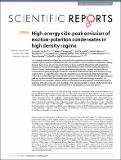Files in this item
High-energy side-peak emission of exciton-polariton condensates in high density regime
Item metadata
| dc.contributor.author | Horikiri, Tomoyuki | |
| dc.contributor.author | Yamaguchi, Makoto | |
| dc.contributor.author | Kamide, Kenji | |
| dc.contributor.author | Matsuo, Yasuhiro | |
| dc.contributor.author | Byrnes, Tim | |
| dc.contributor.author | Ishida, Natsuko | |
| dc.contributor.author | Löffler, Andreas | |
| dc.contributor.author | Hoefling, Sven | |
| dc.contributor.author | Shikano, Yutaka | |
| dc.contributor.author | Ogawa, Tetsuo | |
| dc.contributor.author | Forchel, Alfred | |
| dc.contributor.author | Yamamoto, Yoshihisa | |
| dc.date.accessioned | 2016-05-19T15:30:06Z | |
| dc.date.available | 2016-05-19T15:30:06Z | |
| dc.date.issued | 2016-05-19 | |
| dc.identifier | 241920426 | |
| dc.identifier | c39fa970-2ee5-475e-b2e5-842fd7cb7448 | |
| dc.identifier | 84969972465 | |
| dc.identifier | 000376372200001 | |
| dc.identifier.citation | Horikiri , T , Yamaguchi , M , Kamide , K , Matsuo , Y , Byrnes , T , Ishida , N , Löffler , A , Hoefling , S , Shikano , Y , Ogawa , T , Forchel , A & Yamamoto , Y 2016 , ' High-energy side-peak emission of exciton-polariton condensates in high density regime ' , Scientific Reports , vol. 6 , 25655 . https://doi.org/10.1038/srep25655 | en |
| dc.identifier.issn | 2045-2322 | |
| dc.identifier.uri | https://hdl.handle.net/10023/8837 | |
| dc.description.abstract | In a standard semiconductor laser, electrons and holes recombine via stimulated emission to emit coherent light, in a process that is far from thermal equilibrium. Exciton-polariton condensates -- sharing the same basic device structure as a semiconductor laser, consisting of quantum wells coupled to a microcavity -- have been investigated primarily at densities far below the Mott density for signatures of Bose-Einstein condensation. At high densities approaching the Mott density, exciton-polariton condensates are generally thought to revert to a standard semiconductor laser, with the loss of strong coupling. Here, we report the observation of a photoluminescence sideband at high densities that cannot be accounted for by conventional semiconductor lasing. This also differs from an upper-polariton peak by the observation of the excitation power dependence in the peak-energy separation. Our interpretation as a persistent coherent electron-hole-photon coupling captures several features of this sideband, although a complete understanding of the experimental data is lacking. A full understanding of the observations should lead to a development in non-equilibrium many-body physics. | |
| dc.format.extent | 11 | |
| dc.format.extent | 1258195 | |
| dc.language.iso | eng | |
| dc.relation.ispartof | Scientific Reports | en |
| dc.subject | QC Physics | en |
| dc.subject | TK Electrical engineering. Electronics Nuclear engineering | en |
| dc.subject | NDAS | en |
| dc.subject.lcc | QC | en |
| dc.subject.lcc | TK | en |
| dc.title | High-energy side-peak emission of exciton-polariton condensates in high density regime | en |
| dc.type | Journal article | en |
| dc.contributor.institution | University of St Andrews. School of Physics and Astronomy | en |
| dc.contributor.institution | University of St Andrews. Condensed Matter Physics | en |
| dc.identifier.doi | https://doi.org/10.1038/srep25655 | |
| dc.description.status | Peer reviewed | en |
This item appears in the following Collection(s)
Items in the St Andrews Research Repository are protected by copyright, with all rights reserved, unless otherwise indicated.

